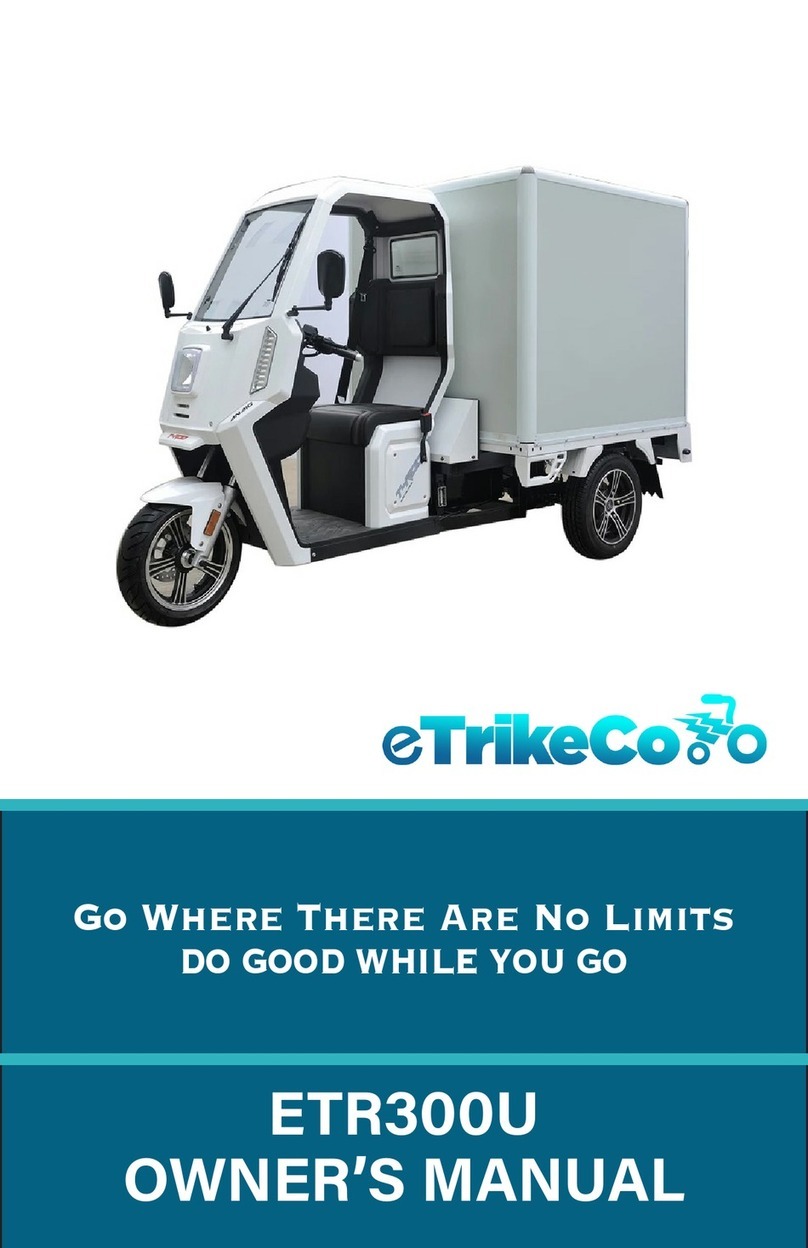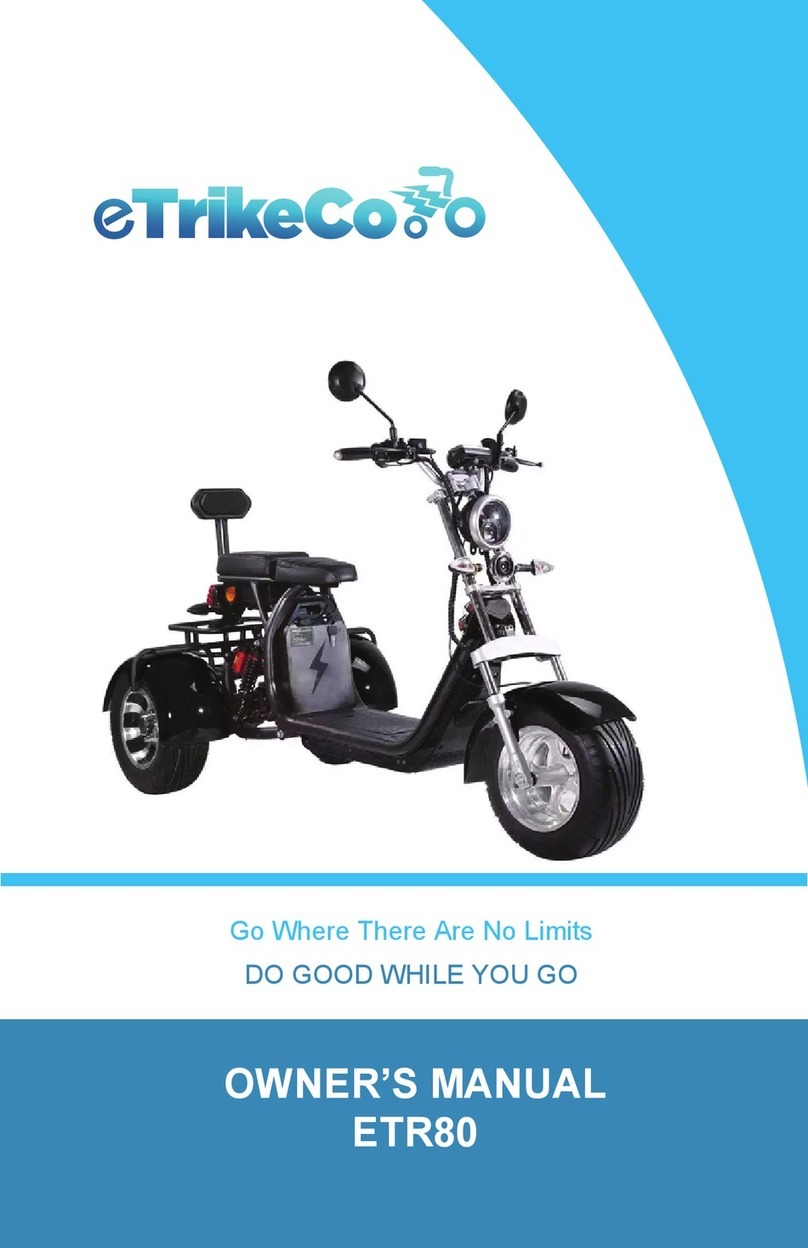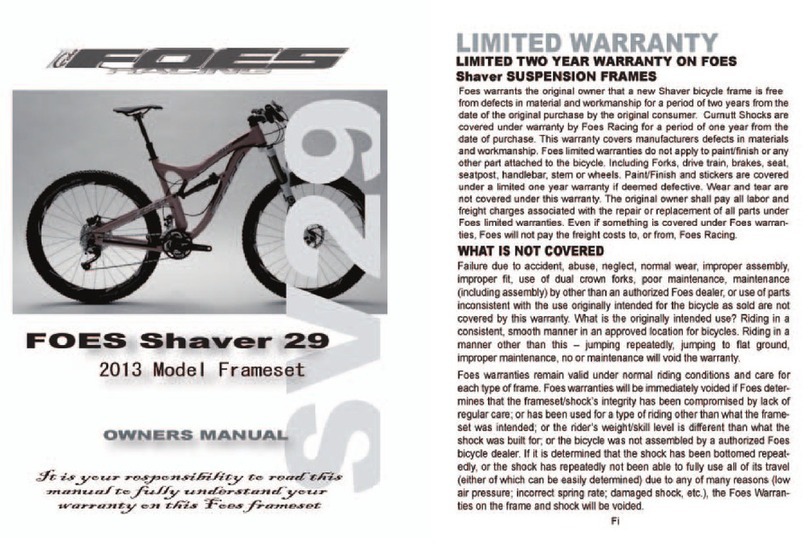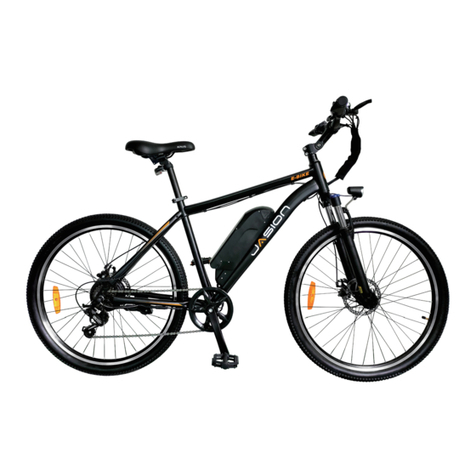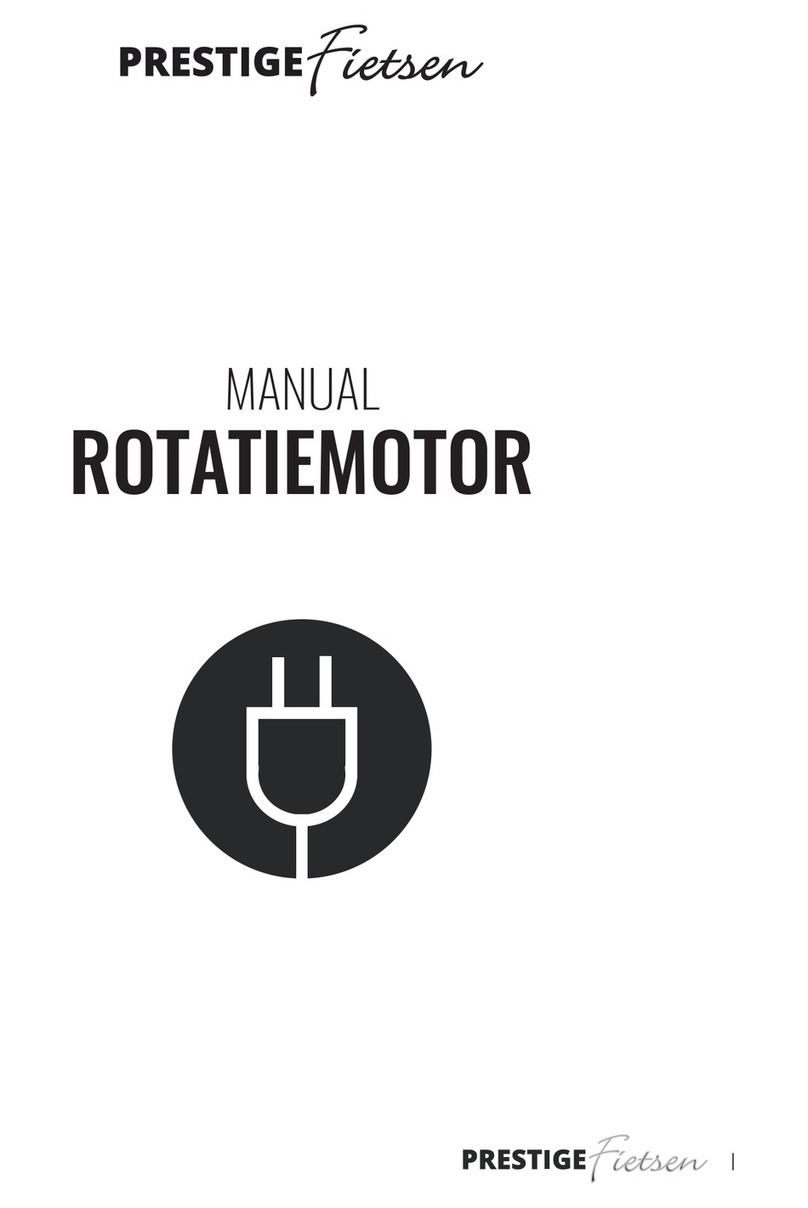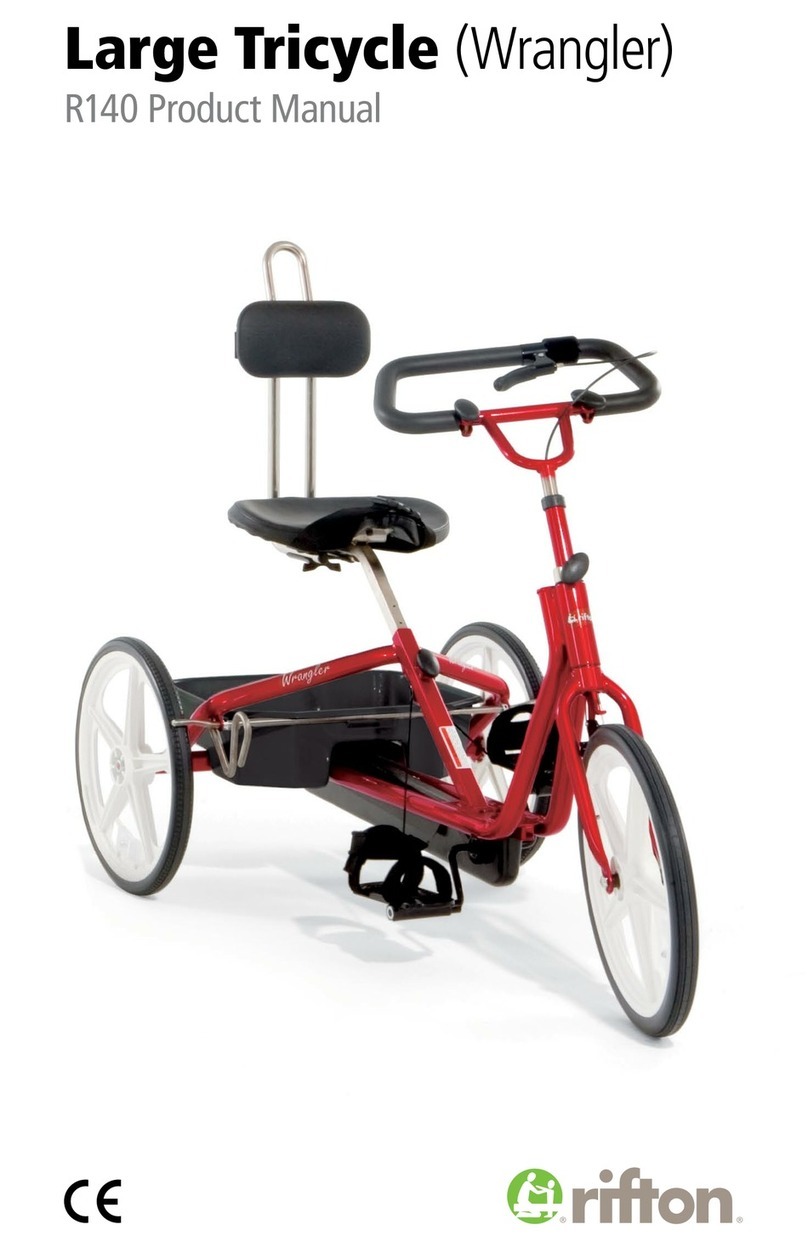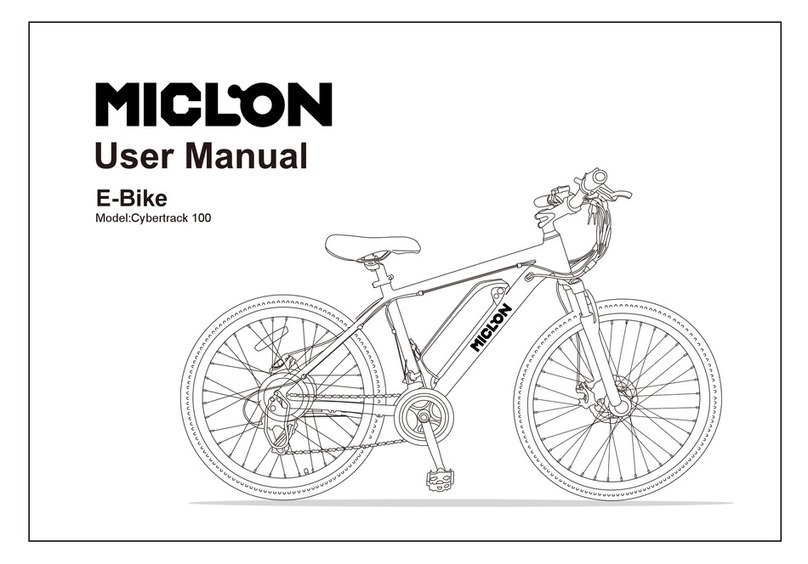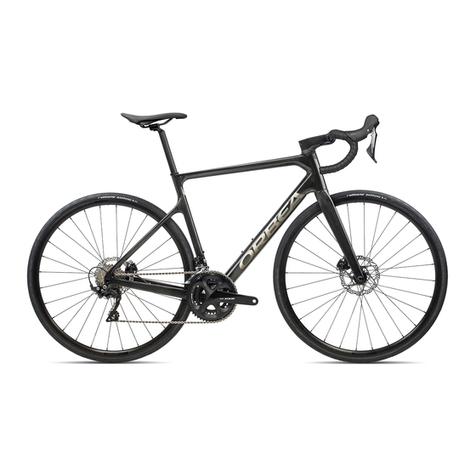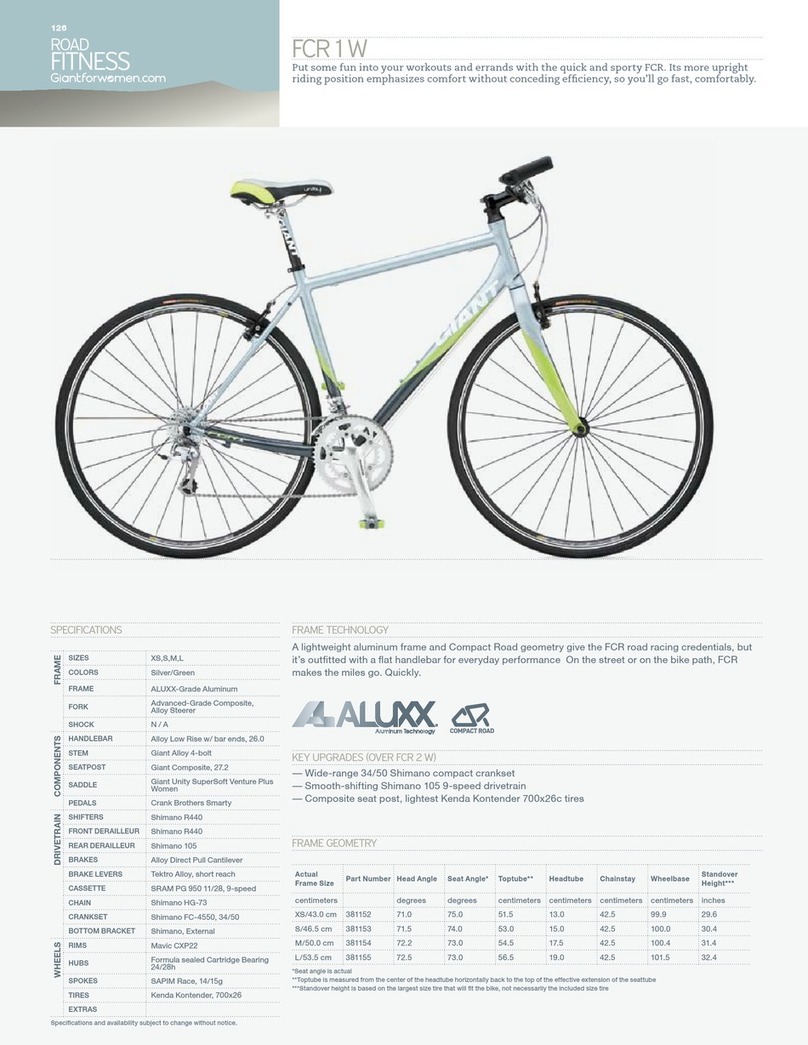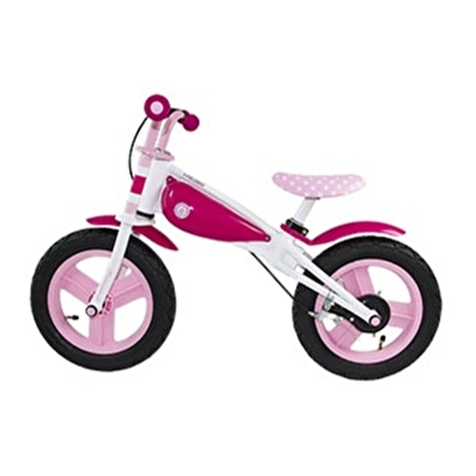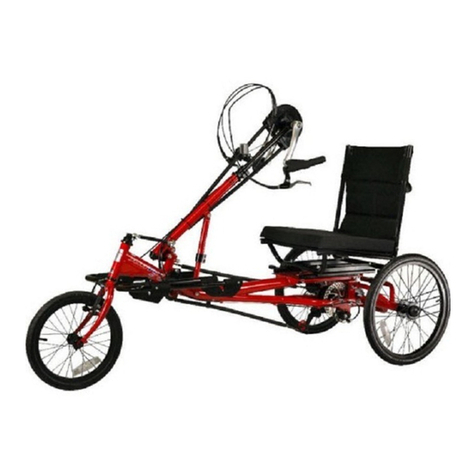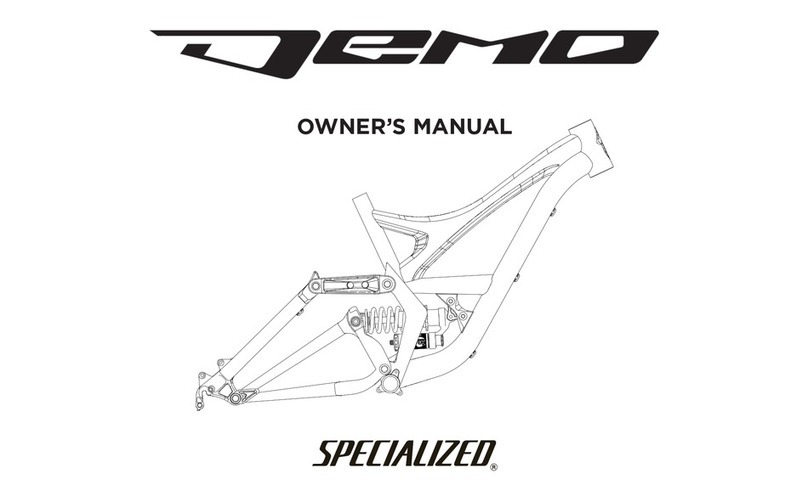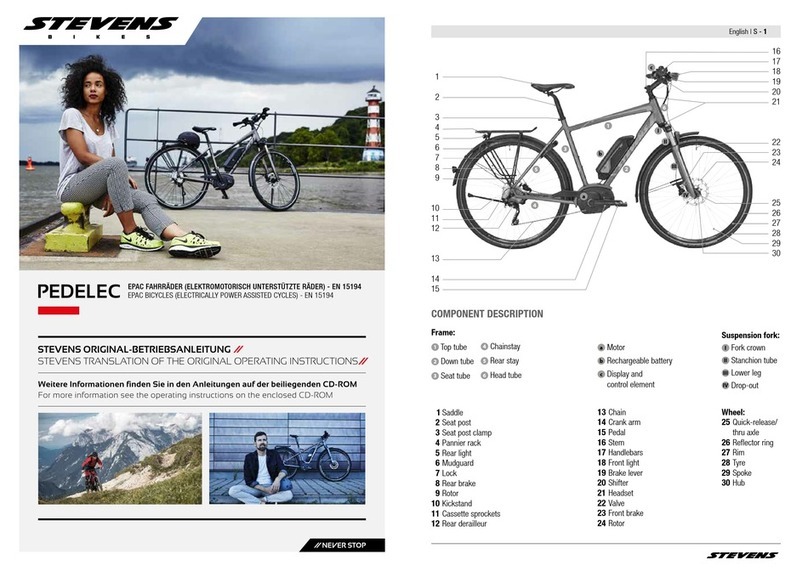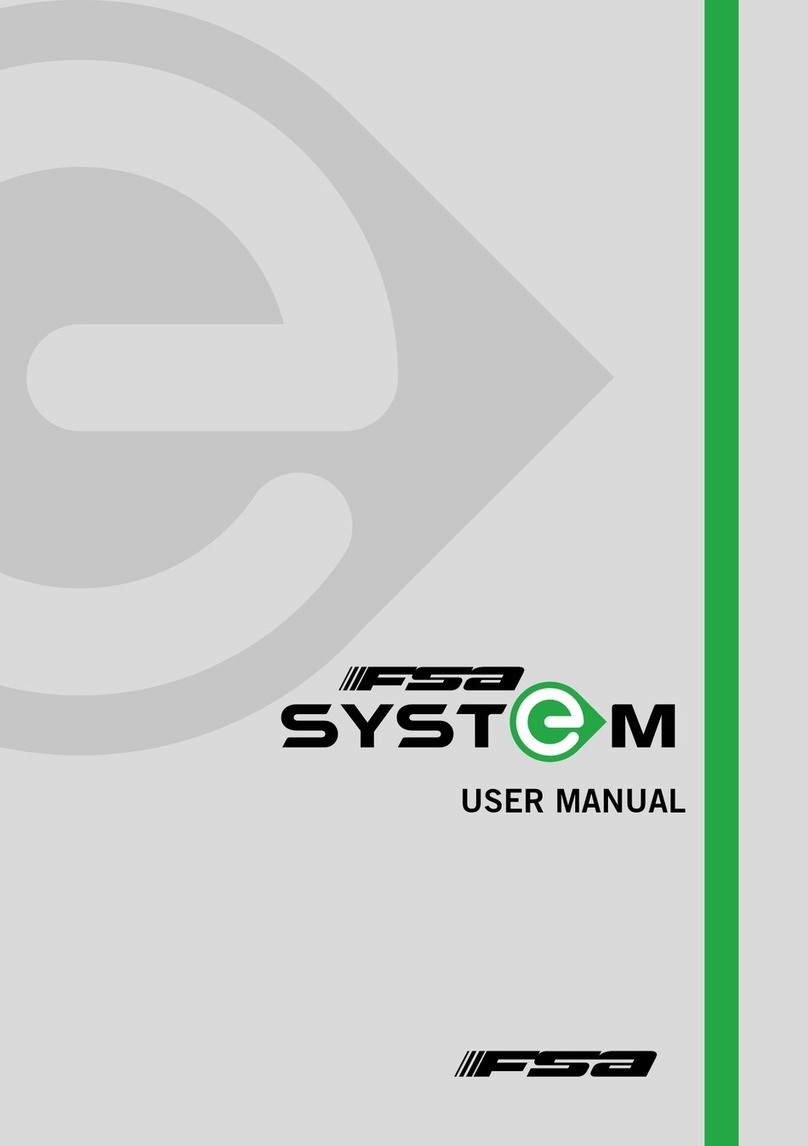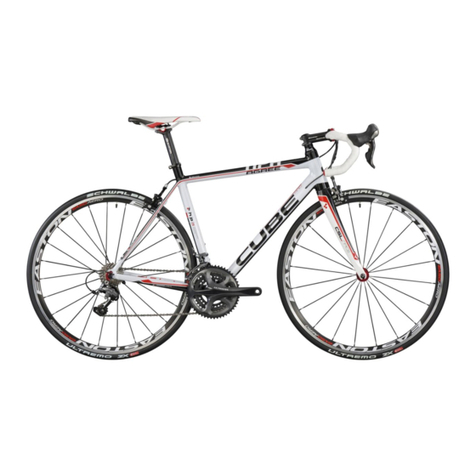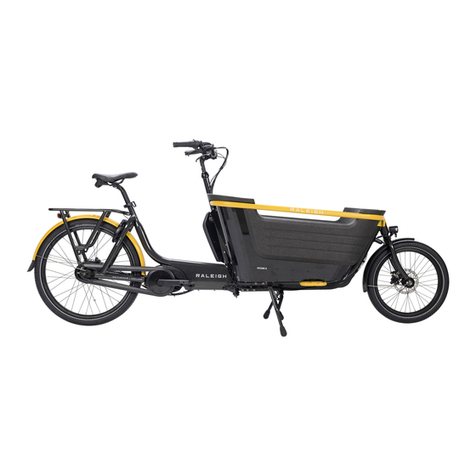eTrikeCo ETR100C User manual

OWNER’S MANUAL
ETR100C
Go Where There Are No Limits
DO GOOD WHILE YOU GO

General Warning
2
3
4

INTRODUCTION
Congratula�ons on the purchase of your new eTrike. This manual is designed to give you
the informa�on that you need for the safe opera�on and maintenance of your eTrike.
Please read it thoroughly before riding your eTrike.
Your eTrike’s serial number is adhered underneath the VIN cap in the front interior panel.
Please record it below in the event that your eTrike is lost or stolen. You may also want to
register your serial number with your local police department. Please retain your sales
receipt as proof of purchase and keep with the informa�on below.
MODEL NO:
SERIAL NO:
COLOR:
DATE OF PURCHASE:

Riding an eTrike involves risk of injury and damage. By choosing to ride an eTrike, you
assume the responsibility for that risk, so it is important to know and practice the rules of
safe and responsible riding, and of proper use and maintenance. Proper use and
maintenance of your eTrike reduces risk of injury.
This manual makes no representation about the safe use of the eTrike under all
conditions. There are risks associated with the use of an eTrike which cannot be
predicted or avoided, and which are the sole responsibility of the rider. As with all
vehicles, practice defensive riding to ensure your safety and the safety of others.
Electric tricycles are relatively new to the vehicle landscape. Riders are at present
generally required to obey current state and local bicycle laws and regulations where
they ride, in addition to relevant motor vehicle and traffic laws. These laws and
regulations vary by jurisdiction. It is the responsibility of the rider to be aware of,
understand and obey these laws and regulations and any changes therein as they affect
the riding of your eTrike. For information on your state and local laws and regulations,
contact the appropriate state and local government offices directly or visit their official
websites.
Laws in your jurisdiction may not require wearing a helmet. For your safety, eTrikeCo
recommends wearing a helmet and protective eye wear when operating your eTrike.
Proper helmets must meet standards set by the Consumer Product Safety Commission
(CPSC).
Also, for your safety and the maximum life service of your eTrike, ensure you understand
and adhere to the capacities for your eTrike model including load, climbing ability and
maximum range.
eTrikeCo further recommends the following resources for helpful information on riding
your eTrike under current bicycle laws. (Note: eTrikeCo does not endorse or claim the
information provided by these resources to be legally accurate. Please refer to your
official state and local laws and regulations to ensure compliance when riding your
eTrike.):
The League of American Bicyclists – www.bikeleague.org
People For Bikes – www.peopleforbikes.org
American Disability Act - www.ada.gov/opdmd.htm
GENERAL WARNING

ROUTINE INSPECTION BEFORE RIDIN
CAUTION
1. Battery - Check the battery life indicator and charge, if needed. Your eTrike can
travel a max range of 55 miles on a full charge. To maximize use per trip, it is
recommended you do not allow the battery capacity to decrease to less than
20%. When the battery is at 20% or lower, promptly charge the battery to full
capacity.
FIRST RIDE: Charge the battery to full capacity before your first ride.
2. Front/rear brakes – Make sure both the front and rear hand brakes engage
effectively to bring the eTrike to a complete stop.
3. Tires – Make sure all ti res are at the recommended 43 psi, and that there is no
damage or extreme wear that compromises their integrity.
NOTE: Improper tire inflation can lead to dangerous conditions including, but, not
limited to abnormal tire wear, tire slippage and other compromises in vehicle
performance.
4. Lights – Make sure the headlight, front/rear turn signals, hazard lights, taillights
including braking lights, function properly.
5. Instrument display – Make sure the display for battery life, speedometer and
odometer functions properly.
6. Horn – Make sure the horn sounds when pushed.
7. Parking break – Make sure the parking brake effectively locks and releases the
brakes.
8. Mirrors – Make sure both mirrors are properly adjusted for effective peripheral
viewing on either side.
9. Steering control/alignment – Make sure the steering column is stable and aligned,
and turns properly to the left and right.
To ensure optimal and safe performance of your eTrike, it is important to
perform the following checks before every ride. Failure to do so could result in
unsafe conditions, poor performance, and/or potential damage to your eTrike.

OPERATING YOUR ETRIKE
CAUTION
The ignition is located on the right side of the front panel.
a. ON – To engage the electric motor and enable the eTrike
to be driven, insert the key into the ignition and turn to
the right or ON position. The key cannot be removed
while it is in the ON position.
b. OFF – To disengage the electric motor, turn the key to
the left or OFF position. Power to the eTrike will be
turned off and the key can then be removed.
Exercise due caution when operating your eTrike in inclement weather and
where conditions on the road, sidewalk or other driving areas may be
hazardous.
Although your eTrike is weather-resistant, prolonged exposure to moisture can
potentially cause minor, temporary shutdown in the vehicle’s circuitry. This
interruption will self-correct once the eTrike is allowed to sufficiently dry out.
AVOID taking turns sharply and at high speed. This can result in tipping the
eTrike.
BOTH HANDS must be used on the steering handles at all times. Sudden and
abrupt turns, not using both hands or riding in uneven terrain while operating
can cause the eTrike to become unstable and tip over.
NEVER drive your eTrike through standing water! Immersion of the motor,
battery or other electrical components can cause short circuits and/or serious
damage to those components.
I. IGNITION SWITCH
The Drive/Neutral/Reverse switch is located on the left side of
the front panel.
a. For REVERSE, move the switch down to the letter (R),
this will enable the reverse camera and it will show on
the instrument display
b. For DRIVE, move the switch up to the letter (D), this will
turn off the back camera.
II. DRIVE/NEUTRAL/REVERSE SWITCH

CAUTION
Release of the throttle does NOT engage the braking system. In order to fully stop the
eTrike from moving, you must engage the brakes.
OPERATING YOUR ETRIKE
a. Grasp the throttle and roll it backwards/
towards you to propel the eTrike.
b. Release the throttle to stop the eTrike
from continuing to propel.
c. For NEUTRAL, move the switch to the middle to the letter (N), this will put the
eTrike on neutral mode.
In addition to the Drive/Neutral/Reverse Switch, the eTrike
comes with a parking switch on the right handler. This switch
disable the throttle.
The throttle controls the flow of electrical power
to the motor which propels the eTrike.
III. PARKING SWITCH
c. The speed of the eTrike can be regulated by adjusting the amount of roll of the
throttle. Full roll to the throttle’s stopping point allows the eTrike to travel at the
maximum speed.
In the United States, bicyclists are required to use
hand signals to alert surrounding traffic of their
intention to turn or change lanes. Your eTrike is
equipped with left and right turn signals which may
be used in place of hand signals for this purpose.
If you opt not to use the turn signals, you must
instead use proper hand signals.
IV. THROTTLE CONTROLLER – RIGHT HANDLE
V. TURNING

Avoid taking turns sharply and at high speed. This can result in tipping the eTrike.
CAUTION
OPERATING YOUR ETRIKE
a. No Signal – The turn signal switch should be in the center OFF position when not
in use.
b. Left Turn/Lane Change – Before making a left turn or lane change, move the turn
signal switch to the left . The front and rear left turn lights will blink. Move the turn
signal switch back to the OFF position once you have completed your turn or lane
change.
c. Right Turn/Lane Change – Before making a right turn or lane change, move the
turn signal switch to the right. The front and rear right turn lights will blink. Move
the turn signal switch back to the OFF position once you have completed your
turn or lane change.
In the United States, bicyclists are required to use a hand signal to alert surrounding
traffic of their intention to slow down or stop. Your eTrike is equipped with rear braking
lights which activate when you engage either hand brake, and which may be used in
place of the hand signal. If the rear braking lights are not functional, you should have the
eTrike serviced immediately for repair. The proper hand signal must be used if riding the
eTrike without rear braking lights.
a. Braking: Release the throttle and squeeze both the front and rear hand brakes
with equal pressure until the eTrike comes to a full stop.
b. Slow Down: Release the throttle and squeeze both the front and rear hand brakes
with enough equal pressure to slow the eTrike down to the desired speed.
VI. SLOWING DOWN/BRAKING
a. Speedometer – Displays your current speed.
b. Battery Life Indicator – Displays the current battery life in percentage and
voltage.
c. Trip Odometer – Displays the mileage per trip/ignition.
VII. INSTRUMENT DISPLAY
Battery life (%) Speedometer
Odometer Battery life (V)

The headlight can be used whenever low visibility in natural light compromises the safe
operati on of your eTrike.
To turn the hazard lights on/off, press the button on the left
handle.
OPERATING YOUR ETRIKE
a. To turn the running light on, move the switch on the
right hand to the middle position.
b. To turn the headlight on, move the switch on the right
hand to the far left.
c. To adjust the brightness, move the switch on the left
hand.
VIII. HEADLIGHT
There are two options of parking brakes:
a. Engaging any of the brake levers.
i. To engage the parking brake levers:
• Your trike must not be in use to insure no movement.
• Once the eTrike is brought to a full stop, turn the key in the ignition to
the OFF position.
IX. HAZARD LIGHTS
Emergency Brake Emergency Brake Lever
Headlight Switch
Brightlight Switch
To sound the horn push down the horn button on either
handle.
X. HORN
XI. PARKING/PARKING BRAKE

• Squeeze the left or right hand brake fully and hold in place.
• Remove the key from the ignition.
ii. To disengage the parking brake
• Hold the hand brake strong enough to release the brake lever to the
original position.
b. Emergency brake located next to the driver’s seat right side.
i. To use the emergency brake located next to the driver’s seat:
• Pull the handle up.
ii. To release it
• Press the button and push it down to the original position.
OPERATING YOUR ETRIKE
XII. POWER OUTLET 12V/120W
The Power Outlet port can be found on the right side of the front
panel next to the Radio.
XIII. RADIO AND BLUETOOTH DEVICE
a. The power button turns the device on/off.
b. The mode button changes the mode to radio or bluetooth. There is also a button
with the bluetooth symbol, this will change the mode instanly to bluetooth.
c. To pair the bluetooth with your smartphone, go to your phone settings, turn on the
bluetooth and select the device corresponding to the eTrike (the name vary per
eTrike). If a pin is required, enter 0000. Once you enter the pin, it will be paired to
your device for use.
d. The back and forward buttons are used to change songs or radio station.
e. The volume buttons increase and decrease the volume of the device. If you are
using your phone paired with bluetooth, check the volume on your smartphone
too.

XIV. WINDSHIELD WIPER/WINDSHIELD WASHER
To activate the wiper blade:
a. Push the windshield wiper button on the left front panel.
For windshield wiper spray:
a. Push the green button located on the top part of the front panel.
To fill the windshield washer:
a. Push the lid located on the right side of the front panel, this will open a
compartment.
b. Turn the interior lid and pour the cleaning liquid inside.
XV. HEATER/DEFOGGER/FAN SWITCH
Push the switch up to activate the heater/defogger.
Push the switch down to activate the fan. To turn off
any function, the switch must be in the middle
position.
XVI. KEY FOB CONTROLS
The eTrike comes equipped with a key fob controller
that allows you to lock and unlock the doors of your
eTrike.
CHARGING YOUR ETRIKE/BATTERY INFORMATION
Windshield Wiper Windshield Washer Cleaning Liquid Reservoir
Heater/Defogger
Fan

CAUTION
CHARGING YOUR ETRIKE/BATTERY INFORMATION
Take reasonable precautions when charging and NEVER use the charger in a damp
environment or in the presence of combustible items.
The charger may become hot during the charging process. To prevent a potential fire
hazard, NEVER cover the charger while charging to allow for the dissipation of heat.
If you encounter any difficulty charging your eTrike or experience unusual oc- currences
in the charging process, immediately shut off the power and contact eTrikeco or
authorized service vendor for service.
Avoid getting any liquid around the battery as this can potentially cause leakage,
overheating smoke and possible explosion.
Your eTrike comes with a battery charger. DO NOT use other chargers to charge your
eTrike. Use the battery life indicator on the eTrike instrument display to gauge the
battery life. To maximize use per trip, do not allow the battery life to decrease to less
than 20%. When the battery life is at 20% or lower, promptly charge the battery to full
capacity.
FIRST RIDE: Charge the battery to full capacity before you take your first ride.
I. CHARGING THE BATTERY
a. Turn the ignition switch to the OFF position
and remove the key. DO NOT charge the
eTrike with the ignition in the ON position.
b. Make sure the battery switch underneath the
rear seat is in the ON position.

CHARGING YOUR ETRIKE/BATTERY INFORMATION
c. Open the cap located in the back of the
eTrike to access the charging port..
d. Plug the receptacle (female) end of the
charger power cable into the eTrike’s
charging port.
e. Plug the charger power cable into a standard
household AC 110V outlet.
NOTE: To protect the eTrike from potential damage as a result of power surges, it is
strongly recommended that a surge protective device is used when plugging into a
standard household AC 110V outlet. Damage resulting from a power surge is not
covered by the warranty.
II. CHARGING THE BATTERY
When the charger power cable is plugged in, the charger box light will be activated.
i. A red light on the charger box indicates that the battery is not fully charged,
but that there is a proper connection and the battery is receiving an electrical
charge. Full charge can take up to 8 hours depending on the level of depletion
in the battery.

CHARGING YOUR ETRIKE/BATTERY INFORMATION
ii. A solid green light on the charger box indicates you’re your eTrike is fully charged.
The charger can be unpluged once the green light is displayed.
III. BATTERY INFORMATION
The lithium ion battery that comes with your eTrike can last approximately 1000 charges
or 3 to 5 years with average use and proper care. Do not use the battery for any other
purpose than to power your eTrike. Do not attempt to disassemble or modify the battery.

PREVENTATIVE MAINTENANCE
All vehicles experience some level of wear over the course of operation. In addition to
performing the Routine Inspection listed in this manual, it is recommended that you
perform preventative maintenance to further ensure the optimal performance and
service life of your vehicle, and for your safety. If you are uncertain of how to perform any
of the following preventative maintenance, seek professional service. Preventative
maintenance should include the following:
a. Keep the motor differential clean to insure proper acceleration and dynamic
performance.
b. Make sure the throttle rotates freely.
c. Make sure the hand brakes and parking brake are operational.
d. Inspect the front and rear shock absorbers for damage and insure both are
functioning properly.
e. Make sure all tires are properly inflated to the recommended psi of 43.
f. Inspect all electrical components to make sure they are functioning properly.
g. Make sure all fasteners and screws are tightly secured throughout the eTrike
body.
h. Keep your eTrike vehicle clean as a buildup of dirt and other substances can
impair proper functioning.
i. Make sure all lubrication points are well-oiled. Do not allow oil to leak onto the
eTrike.
j. Make sure the battery power cable and any attached wires within the battery
compartment are secure.
II. BRAKE INSPECTION AND ADJUSTMENT
It is essential that the brake system, which is engaged by
squeezing both brake handles, be properly adjusted to
allow for adequate clearance while the eTrike is moving,
but still allow for effective braking.

PREVENTATIVE MAINTENANCE
The disc brake system includes brake fluid/oil and is engaged by squeezing the brake
handles, where the brake fluid/oil reservoir is also located. It can be inspected and
maintained as follows:
a. Check the brake fluid/oil level in the reservoir. If the level falls below the bottom
score line, add ONLY either DOT3 or DOT4 brake fluid/oil until it reaches the
upper score line.
NOTE: A drop in the brake fluid/oil level indicates potential plate friction, brake
disc wear or brake fluid leakage, and further inspection into these potential issues
is needed.
b. If the brake fluid/oil changes color, replace it with new braking fluid/oil.
c. Check the friction plate and brake disc wear condition. When any of the friction
plates is worn down to the marking line of 3mm or 3.5mm, it must be replaced in
pairs. The disc brake thickness and wear limits may differ slightly from eTrike
model to model.
d. If the brake handles is spongy or has little resistance or effectiveness when
squeezed, exhaust the brake system as follows:
i. Remove the main cylinder cover and add brake fluid/oil until the fluid level
reaches the upper score line. Close the cover to prevent debris from
entering.
ii. Use a hose with one end connected to the caliper oil drain screw and the
other end to an appropriate container.
iii. Quickly squeeze and release the left hand brake a few times, and then hold
the hand brake in place on the last squeeze.
iv. While the hand brake is being held in place, loosen the air release screw by
turning it counterclockwise one quarter inch. This will allow any foamed
brake fluid/oil to be released through the hose and into the container.
v. Tighten the air release screw.
vi. Repeat steps 3 through 5 until all of the foaming brake fluid/oil is emptied
and the brake handle is no longer spongy and has proper resistance and
effectiveness.
vii. Tighten the drain screw and disconnect the drain pipe.
viii. Add brake fluid/oil to the main cylinder until it reaches the upper score line.
ix. Close the cover.

III. SHOCK ABSORBERS
a. Front shock absorbers – Inspect the front shock
absorbers regularly. Replace the shock
absorbers immediately if damage or failure is
found.
Note: The front fork should be kept clean to insure
proper functioning of the front shock absorbers.
b. Rear shock absorbers – Inspect the rear shock
absorbers after every 125 miles of use. Replace
the shock absorbers immediately if looseness or
cracks are found.
IV. TIRES AND WHEELS
a. Inspect the tires for cuts, embedded objects or
other conditions/damage that can compromise
the tires’ performance.
b. Inspect the tires for proper inflation. This
inspection should always be performed while the
tires are “cold” before driving the vehicle.
Recommended tire pressure is 43 psi.
c. Inspect the wheel rims for dents or distortions
that can adversely affect the tires’ inflation or
performance.
PREVENTATIVE MAINTENANCE
Clean any spilled brake fluid/oil immediately as it can corrode painted surfaces, plastic,
rubber parts, etc. Brake fluid/oil should always remain visible in the viewing window of
the reservoir during the exhausting process. To insure this, add brake fluid/oil to the
main cylinder at any time during the process.
CAUTION

PREVENTATIVE MAINTENANCE
a. Inspect the rear axle and differential every week for proper function. Gear oil
in the axle should be changed approximately every 650 miles.
b. Add gear oil, if needed for proper lubrication.
c. For cold weather, use 80w/90 GL-3 gear oil. For warm weather, use 85w/90
GL-3 gear oil.
a. Check the battery wiring and cable regularly to insure they are secure; any
looseness can cause potential damage to the circuit virtual access.
b. It is recommended that you do not discharge the battery to less than 20%.
Once the battery has been discharged, it should be promptly charged.
c. If the battery shows signs of warping or becomes very hot, stop use
immediately.
a. Store under cover that protects the eTrike from prolonged exposure to the
elements; such exposure can cause mechanical failure and decrease the
service life of your eTrike.
b. When storing your eTrike for an extended period, charge the battery at least
once per month. The recommended storage temperature is 60 degrees
Fahrenheit and at 40% battery capacity.
NOTE: Storing your battery in temperatures below 32 degrees Fahrenheit or
above 97 degrees Fahrenheit can limit your battery life.
c. Charger Storage
When not in use, store the charger in a dry, cool and clean place, taking care
to insure the ventilation holes do not become clogged by dust or other debris.

ETR100C – OVERVIEW - STEERING/CONTROLS

ETR100C – OVERVIEW - STEERING/CONTROLS
Other manuals for ETR100C
1
Table of contents
Other eTrikeCo Bicycle manuals
